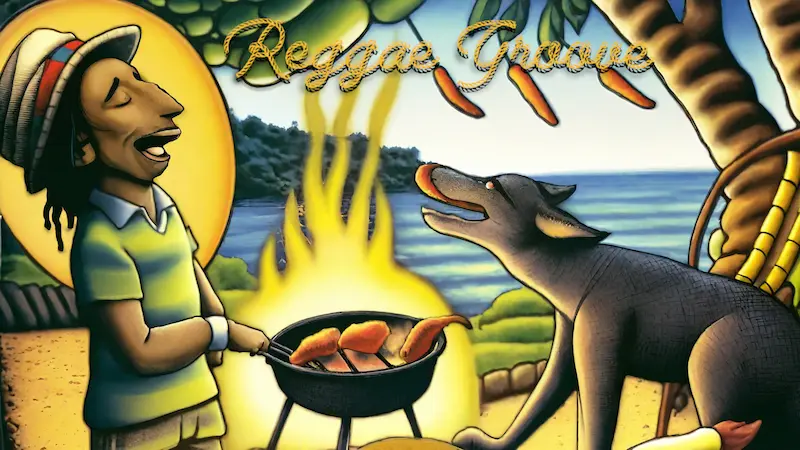
Introduction: Why a Jamaican Patois Translator Matters
I am the quintessential white Jock (Literally as I was born in Scotland) and found myself playing in a reggae band with a group of Jamaican and African friends. The guys were polite and always spoke to me in clear English, but when they spoke to each other I missed much of the conversation.
Over time, and with a bit of coaching, I can now join in the discussion, although the guys still chuckle when I throw in the odd word of Patois with a broad Scottish accent.
If you’ve ever nodded along to a reggae track and felt the vibe while missing some words, you’re not alone. Jamaican Patois, or “Patwa” as many locals call it, is a lively language that often confuses outsiders. More than just slang, it’s a Creole language connected to Jamaica’s history, identity, and music. For reggae fans, a Jamaican Patois translator is more than just a fun tool; it’s essential for understanding hidden meanings, double entendres, and cultural references that add depth to the music.
Consider this, when Bob Marley sings, “Don’t worry ‘bout a ting, ‘cause every likkle ting gonna be alright,” the extra “likkle” isn’t just a cute version of “little.” It shows intimacy, warmth, and comfort that English can’t fully express. Grasping these nuances may seem optional, but once you do, reggae becomes more than background music—it turns into a cultural conversation.
This article aims to be your ultimate guide—a translator of sorts—for understanding Jamaican Patois in reggae. We’ll provide a dictionary of common words and phrases, illustrate how they appear in famous songs, and explore the cultural meanings behind them. Whether you’re a lifelong reggae listener or new to it, this guide will help you appreciate the music in a new way.
A Living Language: The Roots of Jamaican Patois
Before we jump into translations, let’s clarify what Patois is. Linguists describe it as an English-based Creole influenced by West African languages, Spanish, and a bit of Irish. Jamaicans might simply call it “wi language”—our language.
It doesn’t have the standardization of French or Spanish. Grammar is flexible, spelling is subject to change, and pronunciation differs by parish. That adaptability is part of its charm. Patois is perfect for reggae and dancehall lyrics because of its rhythmic delivery. The same word might carry different meanings based on tone, context, or who is speaking.
For a deeper linguistic dive, consult the Wikipedia page on Jamaican Patois.

Jamaican Patois Translator: A Dictionary for Reggae Fans
Here’s an alphabetical list of common Patois words and phrases, complete with English translations and cultural notes. This isn’t a complete list—Patois keeps evolving—but it gives you the basics you’ll hear in reggae songs.
A
A yah suh nice – “It’s nice here.” Often said at parties or relaxed gatherings.
Avin nuff – “Having plenty.” Describes abundance.
B
Bredren – Brother, friend. More than just a buddy; it implies loyalty and shared struggles.
Bway (bwoy) – Boy. Can be affectionate or dismissive depending on the tone.
C
Cyaan – Can’t. For example, “Mi cyaan believe it.”
Criss – Cool, excellent, stylish. Still popular in modern dancehall.
D
Dutty – Dirty, but often used to describe something raw or authentic (e.g., “dutty wine”).
Duppy – Ghost or spirit. Common in folklore and songs.
F
Fyah – Fire, but also symbolizes truth, power, or the destruction of corruption.
G
Gyal – Girl. Common in reggae and dancehall lyrics.
Gwaan – Go on, continue. Example: “Big up, gwaan do yuh ting.”
Ganja – Marijuana
I
Irie – Everything is good, peaceful, alright. A classic Rastafarian expression.
Ital – Natural or pure, often used to describe food in Rastafari culture.
J
Jah – God, derived from Jehovah. Central to Rastafarian beliefs.
Jamrock – Nickname for Jamaica itself.
L
Likkle – Little. A warm and affectionate way of speaking.
Livity – Lifestyle, especially in a spiritual or righteous context.
M
Mash up – Break, destroy, but also used for partying hard.
Mi deh yah – Means “I’m here” or “I’m doing fine”. This is a popular way to greet people.
N
Nuh – Don’t. For example, “Nuh worry.”
Nuff – Plenty, a lot.
P
Pickney – Child. Comes from West African roots.
Pree – To watch, observe, or overthink.
R
Riddim – Rhythm or instrumental track. The backbone of reggae and dancehall.
Run tings – Be in charge, control the situation.
S
Selassie I – Haile Selassie I, Ethiopian emperor and symbol in Rastafari.
Soon come – Not literally “soon,” but “eventually.” A concept of patience.
W
Wah gwaan – “What’s going on?” A common greeting.
Walk good – “Take care.” Often used when parting ways.
Y
Yardie – Jamaican, often used in diaspora communities.
Yute – Youth, young person.This list could go on, but even this short dictionary gives you the basic toolkit of a Jamaican Patois translator.

Patois in Reggae Songs: Famous Examples
Language isn’t just about words; it’s about how they exist in music. Here are some classic reggae tracks where Patois stands out and what the lyrics really mean.
Bob Marley – Pimper’s Paradise
“She loves to party and have a good time; she looks so hearty and feels fine,” the lyrics say. Marley continues, saying, ““She loves to smoke, sometimes shifting coke; she’ll be laughing when there ain’t no joke.”
Even though most of the song is in English, the delivery has a clearly Jamaican rhythm. Marley often mixed English and Patois fluidly, making his music accessible worldwide while still grounded in Jamaica.
Buju Banton – Boom Bye Bye
This song sparked controversy for its lyrics, but it’s a landmark in reggae and dancehall. The line “Boom bye bye inna batty bwoy head” shows raw, street-level Patois. “Batty bwoy” is a derogatory term for a gay man (literal translation is bum boy). While the message is problematic, the phrasing shows how Patois can be direct, even harsh.
Sizzla – Praise Ye Jah
Lyric: “Babylon yuh throne gone down, gone down.” Here, “Babylon” refers to oppressive systems—colonialism, corrupt governments, systemic racism. Understanding this symbolic use of Patois is key to grasping Rastafarian thoughts in reggae.
Damian Marley – Welcome to Jamrock
Lyric: “Out in the streets, they call it murder!” This modern classic is filled with Patois: “Poor people a dead at random, political violence, cyaan done.” Here, “cyaan” (can’t) adds urgency. The use of Patois roots the song in the gritty reality of Jamaica.

Cultural Nuances: Beyond Direct Translation
One tricky aspect of Patois is that it doesn’t directly translate to English. Tone can change meaning. A phrase that sounds confrontational to someone from outside might actually be friendly banter.
Take “Wah gwaan, mi yute?” Can have two meanings. Mostly, it is simply “What’s up, my friend?”. But if said with a grough tone, it could imply “What’s your problem?” Context is everything.
Also, some words have spiritual significance. “Fyah” in Rastafarian use isn’t just fire; it symbolizes cleansing and the removal of corruption. If you translate it literally, you lose the depth of the expression.Time also plays a role. Visitors to Jamaica are accustomed to hearing the term “soon come.” It doesn’t mean in five minutes; it means, “Relax, it will happen when it happens.” To outsiders, it might seem frustrating; to Jamaicans, it reflects a different sense of time.

How a Jamaican Patois Translator Helps Reggae Fans
Why should you learn all this? A Jamaican Patois translator—whether a dictionary, app, or article like this—opens up reggae lyrics in ways that enhance your listening experience. You progress from merely glancing at the surface to recognizing the wordplay, the jokes, and the social criticism that is concealed in plain sight.
It also connects cultures. Reggae is now global, reaching from Tokyo to Lagos to São Paulo. People sing along everywhere. But without understanding Patois, many meanings get lost. Learning even a few phrases helps you join the conversation rather than just observe.
Practical Tips for Learning Patois
- Listen actively: Don’t let the music play without paying attention. Pause, rewind, and write down lyrics you don’t understand.
- Compare versions: Many reggae songs have live versions where the artist explains or expands on the lyrics. Those moments are golden for learners.
- Chat with Jamaicans: If you know Jamaican friends, ask them about phrases. They’ll likely provide more context than any dictionary.
- Use subtitles: Some reggae documentaries offer English subtitles. Watching and listening simultaneously can be helpful.
- Start small: Begin with greetings and common expressions. “Wah gwaan?” is a great starting point.
Where Audio Helps
Text is useful, but Patois is all about sound. Pronunciation carries rhythms that text can’t always convey. Ideally, this article would include audio—like a native speaker saying the words, allowing you to mimic the intonation.
Imagine clicking on “Irie” and hearing the soothing rise and fall. Or hearing “Wah gwaan” with its crisp beginning. If you’re serious about learning, pairing text with audio is the best approach.
Final Thoughts
Reggae without Patois is like curry without spice. You still enjoy the meal, but you miss the heat, flavor, and soul. Having a Jamaican Patois translator—whether it’s a guide like this, an app, or a Jamaican friend sharing lyrics—lets you dive deeper into the culture that reggae embodies. You’ll begin to hear the wisdom in Marley’s simplicity, the defiance in Sizzla’s chants, and the raw storytelling in Damian Marley’s verses.And who knows? The next time someone sings, “Every likkle ting gonna be alright,” you might smile a little wider, knowing that “likkle” has a rich world behind it.





